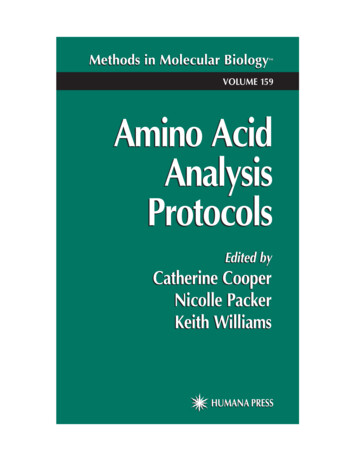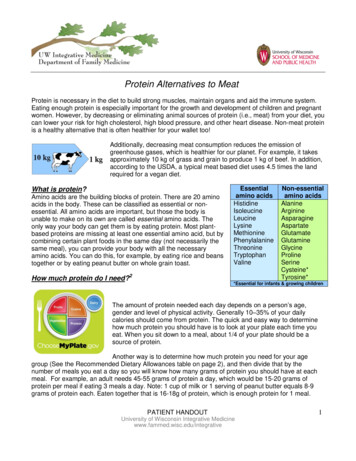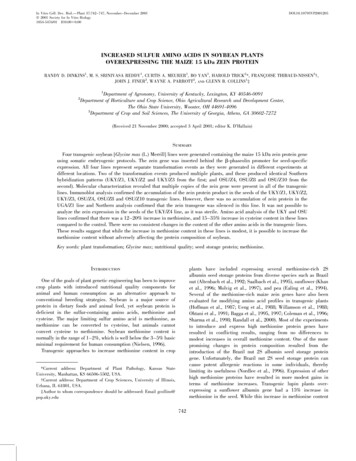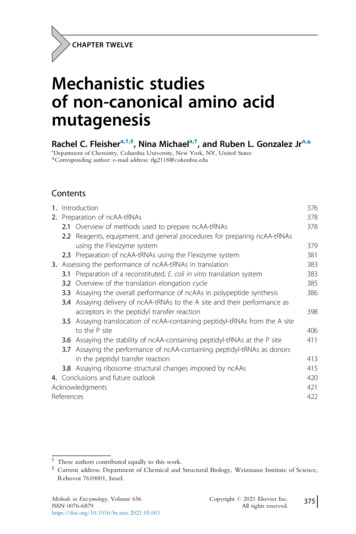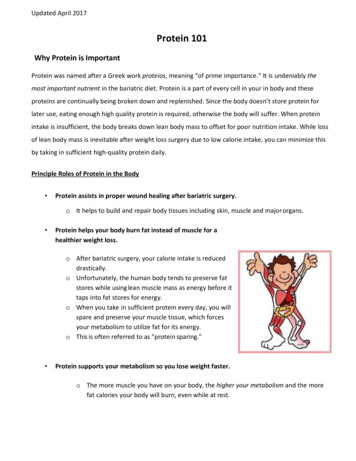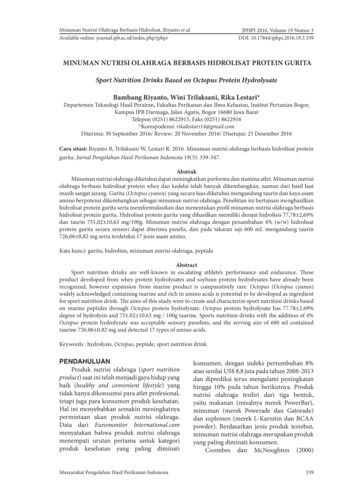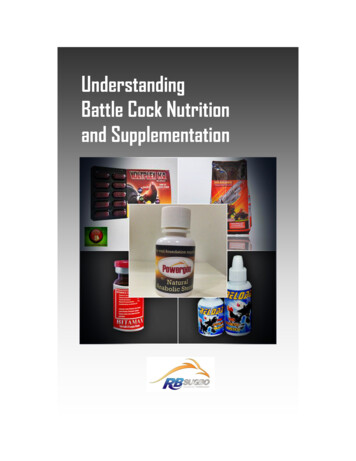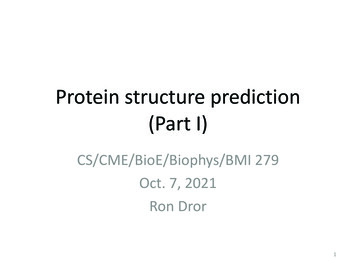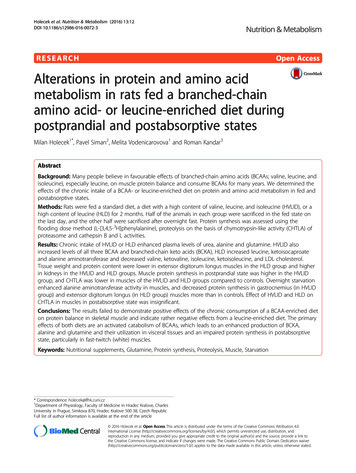
Transcription
Holecek et al. Nutrition & Metabolism (2016) 13:12DOI 10.1186/s12986-016-0072-3RESEARCHOpen AccessAlterations in protein and amino acidmetabolism in rats fed a branched-chainamino acid- or leucine-enriched diet duringpostprandial and postabsorptive statesMilan Holecek1*, Pavel Siman2, Melita Vodenicarovova1 and Roman Kandar3AbstractBackground: Many people believe in favourable effects of branched-chain amino acids (BCAAs; valine, leucine, andisoleucine), especially leucine, on muscle protein balance and consume BCAAs for many years. We determined theeffects of the chronic intake of a BCAA- or leucine-enriched diet on protein and amino acid metabolism in fed andpostabsorptive states.Methods: Rats were fed a standard diet, a diet with a high content of valine, leucine, and isoleucine (HVLID), or ahigh content of leucine (HLD) for 2 months. Half of the animals in each group were sacrificed in the fed state onthe last day, and the other half were sacrificed after overnight fast. Protein synthesis was assessed using theflooding dose method (L-[3,4,5-3H]phenylalanine), proteolysis on the basis of chymotrypsin-like activity (CHTLA) ofproteasome and cathepsin B and L activities.Results: Chronic intake of HVLID or HLD enhanced plasma levels of urea, alanine and glutamine. HVLID alsoincreased levels of all three BCAA and branched-chain keto acids (BCKA), HLD increased leucine, ketoisocaproateand alanine aminotransferase and decreased valine, ketovaline, isoleucine, ketoisoleucine, and LDL cholesterol.Tissue weight and protein content were lower in extensor digitorum longus muscles in the HLD group and higherin kidneys in the HVLID and HLD groups. Muscle protein synthesis in postprandial state was higher in the HVLIDgroup, and CHTLA was lower in muscles of the HVLID and HLD groups compared to controls. Overnight starvationenhanced alanine aminotransferase activity in muscles, and decreased protein synthesis in gastrocnemius (in HVLIDgroup) and extensor digitorum longus (in HLD group) muscles more than in controls. Effect of HVLID and HLD onCHTLA in muscles in postabsorptive state was insignificant.Conclusions: The results failed to demonstrate positive effects of the chronic consumption of a BCAA-enriched dieton protein balance in skeletal muscle and indicate rather negative effects from a leucine-enriched diet. The primaryeffects of both diets are an activated catabolism of BCAAs, which leads to an enhanced production of BCKA,alanine and glutamine and their utilization in visceral tissues and an impaired protein synthesis in postabsorptivestate, particularly in fast-twitch (white) muscles.Keywords: Nutritional supplements, Glutamine, Protein synthesis, Proteolysis, Muscle, Starvation* Correspondence: holecek@lfhk.cuni.cz1Department of Physiology, Faculty of Medicine in Hradec Kralove, CharlesUniversity in Prague, Simkova 870, Hradec Kralove 500 38, Czech RepublicFull list of author information is available at the end of the article 2016 Holecek et al. Open Access This article is distributed under the terms of the Creative Commons Attribution 4.0International License (http://creativecommons.org/licenses/by/4.0/), which permits unrestricted use, distribution, andreproduction in any medium, provided you give appropriate credit to the original author(s) and the source, provide a link tothe Creative Commons license, and indicate if changes were made. The Creative Commons Public Domain Dedication o/1.0/) applies to the data made available in this article, unless otherwise stated.
Holecek et al. Nutrition & Metabolism (2016) 13:12BackgroundThe branched-chain amino acids (BCAAs) valine, leucine and isoleucine are essential substrates and important regulators in the synthesis of body proteins,substrates for energy production and precursors for theformation of other amino acids. The stimulatory effectof BCAAs on protein synthesis and the inhibitory effecton proteolysis have been known for many years [1–3].Particularly, leucine was implicated in the stimulation ofprotein synthesis in skeletal muscle. Leucine enhancesinsulin release from β-cells of the pancreas and directlystimulates protein synthesis through the mammalian target of rapamycin (mTOR) signalling pathway and thephosphorylation of translation initiation factors andribosomal proteins [4, 5]. The inhibitory effect ofBCAAs on proteolysis is likely mediated by several metabolites of BCAAs, particularly branched-chain ketoacids and beta-hydroxy-beta-methylbutyrate [6, 7].The initial site for most BCAA catabolism is skeletalmuscle because of the high activity of BCAA aminotransferase, which enables the transfer of the aminogroup of BCAAs to α-ketoglutarate to form glutamateand branched-chain keto acids (BCKA), i.e., αketoisocaproate (KIC, ketoleucine), α-keto-β-methylvalerate (KMV, ketoisoleucine) and α-ketoisovalerate (KIV,ketovaline). The enhanced availability of glutamic acidincreases the flux through glutamine synthetase and alanine aminotransferase leading to enhanced synthesis ofglutamine and alanine. These amino acids are releasedtogether with most of the BCKA from skeletal muscle tothe blood [8–10]. Overall, an enhanced intake of BCAAsshould lead to enhanced BCAA catabolism and the release of glutamine, alanine and BCKA from muscles tothe blood stream (Fig. 1).The unique effects of BCAAs on protein metabolismled to the use of BCAAs in patients with cachectic disorders and as popular dietary supplements, especially inathletes. However, chronic and excessive intake of theBCAAs raises concerns of their adverse side effects. Thechronic intake of high amounts of BCAAs may inducePage 2 of 12an imbalance in amino acid concentrations in bodyfluids, alter various biochemical pathways and cellularfunctions, and the response of the body to differentphysiological and pathological conditions, such as starvation, exercise, trauma, infection, and cancer development. Unfortunately, few studies have investigated thelong-term effects of BCAA supplementation, and thereis a lack of information on the side effects and consequences of the long-term intake of these supplements.We determined how the chronic intake of a BCAA- orleucine-enriched diet affected protein and amino acidhomeostasis, particularly the effect on protein balance inskeletal muscle and on the concentrations of free aminoacids in extracellular and intracellular spaces, especiallyBCAA, alanine, and glutamine levels. Various types ofhindlimb muscles were examined, including m. soleus(SOL, slow-twitch, red muscles), m. extensor digitorumlongus (EDL, fast-twitch, white muscle), and m. gastrocnemius (GM, both fibre types), because of reported differences in protein, BCAA and glutamine metabolism inslow-twitch and fast-twitch muscles [11–13].The effects of BCAA- or leucine-enriched diet havebeen examined in two nutritionally different conditions—in fed and overnight fasted animals. In fed (postprandial) state are concentrations of nutrients in body fluidsclosely related to composition of the food and anabolicresponse of the body mediated by enhanced secretion ofinsulin. After overnight fast (in postabsorptive state) isthe effect of food composition on concentration of nutrients in extracellular fluid smaller and the main role playgradual decrease in insulin/glucagon ratio and enhancedcatabolism of glycogen, lipids, and proteins.MethodsAnimals and materialMale Wistar rats (BioTest, Konarovice, CR) were housedin standardised cages in quarters with controlledtemperature and a 12-h light–dark cycle. All rats received the standard laboratory diet (SLD) ST-1 (Velas,CR) and drinking water ad libitum. All proceduresFig. 1 The primary pathways of BCAA catabolism in skeletal muscle and the supposed response of skeletal muscle and liver to surplus exogenousBCAAs. 1, BCAA aminotransferase; 2, BCKA dehydrogenase; 3, glutamine synthetase; 4, alanine aminotransferase (ALT)
Holecek et al. Nutrition & Metabolism (2016) 13:12Page 3 of 12involving animals were performed according to theguidelines set by the Institutional Animal Care and UseCommittee of Charles University. Animal Care and UseCommittee of Charles University in Prague, Faculty ofMedicine in Hradec Kralove specifically approved thisstudy. L-[3,4,5-3H]phenylalanine was purchased fromAmerican Radiolabeled Chemical, Inc. (St. Louis, MO,USA). Chemicals were obtained from Sigma Chemical(St. Louis, MO, USA), Lachema (Brno, CR), Waters(Milford, MA, ISA), Biomol (Hamburg, Germany), andMerck (Darmstadt, Germany).and jejunum were quickly removed and frozen in liquidnitrogen. Tissue samples were homogenized in 6 % (v/v)perchloric acid, and the precipitated proteins were collected via centrifugation for 5 min at 12,000 g. Thesupernatant was used for the measurement of L-[3,4,53H]phenylalanine specific activity. The pellet was washedthree times and hydrolysed in 2 N NaOH. Aliquots weretaken for protein content [18] and radioactivity measurements. The fractional rate of protein synthesis (FRPS)was calculated according the formula derived by McNurlan et al. [19]:FRPS ð% per dayÞ ¼ ðS b 100Þ ðt S a ÞExperimental designA total of 120 male Wistar rats weighing approximately200 g each were randomly divided into three groups fedan SLD or a diet in which 10 % of the basal diet was replaced by a mixture of valine, leucine, and isoleucine inratios of 1 : 1 : 1 (HVLID, high valine, leucine, and isoleucine diet) or leucine (HLD, high leucine diet). Themixtures were used to prepare pellets with the samephysical properties and consistency. Estimated contentsof L-valine, L-leucine, and L-isoleucine (g/kg diet) areshown in Table 1. These contents resemble a high-dosesupplementation in which adverse outcomes for themonitored variables were not reported [14–16].The animals consumed tested diets for 2 months andwere sacrificed between 7 and 8 a.m. on the last day ofthe study protocol. Half of the animals in each groupwere sacrificed in the fed state, and the other half weresacrificed after an overnight fast. Two separate studieswere performed. Tissue protein synthesis rates weremeasured using the flooding dose method (L-[3,4,53H]phenylalanine) in the first study. Alterations in aminoacid concentrations in body fluids and various parameters of protein and amino acid metabolism were estimated in the second study.Protein synthesisThe rats were injected intravenously with a floodingdose of L-[3,4,5-3H]phenylalanine (50 μCi/100 g b.w.)combined with unlabelled L-phenylalanine (150 μmol/100 g b.w.) 10 min before the sacrifice by exsanguinationvia the abdominal aorta [17]. Small pieces (approximately 0.1 g) of soleus (SOL), gastrocnemius (GM), andextensor digitorum longus (EDL) muscles, liver, kidneys,where Sb and Sa are the specific activities (dpm/nanomole) of protein-bound phenylalanine and tissue-freephenylalanine in the acid-soluble fraction of tissue homogenates, respectively, and t is the time (days) betweenisotope injection and tissue immersion into liquid nitrogen. The value of 274 μmol phenylalanine/g protein wasused for the calculation of protein-bound phenylalaninespecific activity [20]. Sample radioactivity was measuredusing a liquid scintillation radioactivity counter LS 6000(Beckman Instruments, Fullerton, CA, USA).Amino acid concentrations in blood plasma and tissuesAmino acid concentrations were determined in the supernatants of deproteinised blood plasma and tissuesamples using high-performance liquid chromatography(Aliance 2695, Waters, Milford, MA, USA) after derivatisation with 6-aminoquinolyl-N-hydroxysuccinimidylcarbamate. The intracellular concentration of eachamino acid was calculated by subtracting the free extracellular portion from the total amount, assuming theplasma concentration to be equal to the concentrationin the interstitial fluid as described by Bergstrőm et al.[21]. Total tissue water was measured from the tissueweight obtained after drying for 24 h at 90 C. The determination of extra- and intracellular water was basedon the chloride method according to Graham et al. [22].BCKA concentrations in blood plasma were measuredusing liquid chromatograph (Shimadzu, Kyoto, Japan)after precolumn derivatisation with o-phenylenediamine[23].Chymotrypsin-like activity (CHTLA)Table 1 Estimated contents of L-valine, L-leucine, and Lisoleucine in experimental diets (g/kg diet)DietValine (g/kg)Leucine (g/kg)Isoleucine (g/kg)SLD142112HVLID465044HLD1312011SLD standard laboratory diet; HVLID diet with high content of valine, leucine,and isoleucine; HLD high leucine dietThe chymotrypsin-like activity of proteasomes was determined using the fluorogenic substrate Suc-LLVYMCA [24] as follows. The muscles were homogenised in0.4 ml of ice-cold 20 mM Tris buffer, pH 7.5, containing2 mM ATP, 5 mM MgCl2 and 1 mM dithiothreitol. Thehomogenates were centrifuged for 10 min at 18,000 g at4 C. Cellular supernatants (0.1 ml) were incubated with0.1 ml of substrate Suc-LLVY-MCA (0.1 mM) with or
Holecek et al. Nutrition & Metabolism (2016) 13:12without inhibitor MG132 (0.02 mM) for 1 h on ice. Avolume of 0.4 ml of 100 mM sodium acetate buffer(pH 4.3) was added to stop the reaction. Sample fluorescence was immediately determined at an excitationwavelength of 340 nm and emission wavelength of440 nm (Tecan InfiniteTM 200). The standard curve wasestablished for 7-amino-4-methylcoumarin (AMC),which permitted the expression of CHTLA as nmol ofAMC/g protein/hour. The activity was adjusted for theprotein concentration of the supernatant. Differencesafter the subtraction of inhibited from non-inhibited activities were used for calculations.Page 4 of 12ResultsEffects of HVLID and HLD on food intake, body weightand blood biochemistryThe intake of HVLID was lower than the intake of SLDand HLD in the initial phase of the study. Differences indaily food intake were not significant beginning the second week. There were no differences in body weightgain between animals receiving the various diets (Fig. 2).Higher blood plasma concentrations of urea were observed in animals that chronically consumed HVLID orHLD. In HLD fed animals we observed higher ALT activity and lower concentration of LDL cholesterol andatherogenicity index than in controls (Table 2).Cathepsin B and L activitiesThe activities of cathepsin B and L were determinedusing the fluorogenic substrate Z-FA-MCA [25, 26] asfollows. Tissue samples (approximately 20 mg) werehomogenised in 0.6 ml of ice-cold 300 mM sodium acetate buffer, pH 5.0, containing 4 mM EDTA, 8 mM dithiothreitol and 0.2 % Triton X-100 (v/v). Thehomogenates were allowed to stand for 30 min on iceand centrifuged for 30 min at 18,000 g at 4 C. Cellularsupernatant (0.01 ml) were incubated with 0.19 ml ofsubstrate Z-FA-MCA (0.1 mM) with or without the inhibitor Z-FF-FMK (0.04 mM) for 30 min at 37 C. Thereaction was stopped by the addition of 1 ml of 100 mMsodium acetate buffer, pH 4.3, and the activities of cathepsin B and L were determined as described above forCHTLA.Other techniquesGlutamine synthetase activity was determined usinga colorimetric assay based on the formation of γglutamyl-hydroxamate [27]. The catalytic concentration of alanine aminotransferase was determinedfrom the rate of decrease of NADH, measured at340 nm, by lactate dehydrogenase [28]. Enzyme activities are reported per milligram of protein of reaction mixture. Plasma levels of urea, creatinine, ALT,AST, glucose, triglycerides, and cholesterol weremeasured using commercial tests (Boehringer, Mannheim, Germany; Elitech, Sées, France and Lachema,Brno, CR).StatisticsResults are expressed as means SE. Analysis of variance (ANOVA) followed by Bonferroni multiple comparison post hoc analysis was used to detectdifferences between multiple independent groups.NCSS 2001 statistical software (Kaysville, UT, USA)was used for analyses. Differences were consideredsignificant at P 0.05.Effects of HVLID and HLD on amino acid and BCKAconcentrations in blood plasmaPlasma concentrations of BCAA, BCKA, alanine, andglutamine increased significantly in animals fed HVLID.Enhanced concentrations of leucine, KIC, glutamine andalanine were also found in animals fed HLD, but concentrations of valine, isoleucine, KIV and KMV were significantly lower than controls. Overnight starvationdecreased the plasma concentration of most amino acidsin controls and normalised alterations induced by the intake of HVLID or HLD (Table 3 and Fig. 3).Effects of HVLID and HLD on amino acid concentrationsin tissuesHVLID increased levels of valine, leucine, and isoleucineand HLD increased leucine and decreased valine andisoleucine concentrations in all muscle types (Table 4).In other tissues the effects of HVLID and HLD were lesssignificant (Table 5). Alanine concentrations were higherin all muscle types of animals that consumed HVLID orHLD and in the jejunum and kidneys of animals thatconsumed HLD. Glutamine concentrations increasedsignificantly only in muscles of the HLD group. Most ofthe alterations in intracellular amino acid concentrationsthat were induced by the chronic intake of HVLID orHLD in the postprandial state disappeared after an overnight fast.Effects of HVLID and HLD on glutamine synthetase andalanine aminotransferase activitiesThe effect of chronic HVLID or HLD consumption onglutamine synthetase and alanine aminotransferase inmuscles was not significant. Overnight starvation had noeffect on glutamine synthetase, but a significant increasein alanine aminotransferase activity in muscles wasfound in the SOL and MG of animals fed various dietsand the EDL of animals fed SLD before an overnight fast(Figs. 4 and 5).
Holecek et al. Nutrition & Metabolism (2016) 13:12Page 5 of 12Fig. 2 Food intake and body weight changes in rats fed an SLD, HVLID and HLD. Means SE, p 0.05. *compared to the SLD group; † HLD groupvs. HVLID groupEffects of HVLID and HLD on protein synthesisThe fractional rate of protein synthesis (Fig. 6) washigher in the postprandial state in MG and SOL of animals fed an HVLID and in the jejunum of animals fedan HLD. A decrease in protein synthesis was found inmuscles after an overnight fast. The decrease was morepronounced in gastrocnemius muscles of animals thatconsumed HVLID and in EDL muscles of animals thatconsumed HLD. Higher values of protein synthesis wereobserved in the postabsorptive state in the kidneys ofHVLID and HLD groups compared to controls.Effects of HVLID and HLD on protein breakdownConsumption of HVLID decreased CHTLA activities inthe muscles; HLD decreased CHTLA activities in themuscles, liver, jejunum, and kidneys (Fig. 7). Cathepsin Band L activities (Table 6) increased in the jejunum of theHVLID group. Lower activities were found in the SOLand jejunum of animals that consumed HLD comparedto animals fed by HVLID. Effect of HVLID and HLD onCHTLA in muscles in postabsorptive state was insignificant. Cathepsin B and L activities in the jejunum andEDL of HVLID and HLD groups were lower than controls fed SLD before an overnight fast.Effects of HVLID and HLD on weight and protein contentof tissuesThe effect of HVLID on muscle weight and protein content was not significant, but lower weight and proteincontent was found in EDL of animals that consumedHLD. Chronic intake of HVLID and HLD significantlyincreased the weight and protein content of the kidneys.Table 2 Changes in blood plasmaFed animalsOvernight starved animalsSLD (n 10)HVLID (n 10)HLD (n 9)SLD S (n 10)HVLID S (n 10)HLD S (n 10)Glucose (mmol/l)9.67 0.21chylosity8.58 0.29 a7.17 0.18 b8.84 0.28 a7.96 0.24Urea (mmol/l)7.32 0.219.60 0.14 a8.86 0.32 a6.31 0.25 b8.23 0.24 a,b9.00 0.36 aCreatinine (μmol/l)27.9 1.029.4 1.127.6 0.630.2 1.330.9 1.729.9 0.85ALT (μkat/l)0.88 0.050.97 0.061.22 0.03 a,c0.68 0.04 b0.59 0.05 a0.86 0.06 a,b,cAST (μkat/l1.35 0.151.33 0.051.16 0.061.26 0.051.29 0.061.15 0.05Cholesterol (mmol/l)1.64 0.111.49 0.081.54 0.121.42 0.101.47 0.061.30 0.071.24 0.091.02 0.041.16 0.070.20 0.03 b0.28 0.02cHDL cholesterol (mmol/l)1.08 0.120.99 0.041.31 0.10LDL cholesterol (mmol/l)0.29 0.03chylosity0.17 0.03 aa0.19 0.020.95 0.06Atherogenicity index0.39 0.030.51 0.05Triglycerides (mmol/l)1.25 0.070.72 0.08 aa,cb0.47 0.030.79 0.10 b0.60 0.070.14 0.02Total protein (g/l)63.1 0.763.0 0.764.6 1.258.0 0.6Albumins (mmol/l)35.3 1.434.7 1.135.7 1.833.1 0.8b61.4 0.834.8 1.6a0.12 0.01 ca0.12 0.02 c0.86 0.1160.3 0.7b33.7 1.2Means SE, p 0.05SLD standard laboratory diet; SLD S rats fed SLD starved overnight before sacrifice; HVLID diet with high content of valine, leucine, and isoleucine; HVLID S ratsfed HVLID starved overnight before sacrifice; HLD high leucine diet; HLD S rats fed HLD starved overnight before sacrificeacompared to the corresponding control (SLD or SLD S)bcompared to the corresponding fed groupcHLD (HLD S) vs. HVLID (HVLID S). Atherogenicity index was calculated as: (cholesterol-HDL cholesterol)/HDL cholesterol
Holecek et al. Nutrition & Metabolism (2016) 13:12Page 6 of 12Table 3 Amino acid concentrations (μmol/l) in blood plasmaFed animalsOvernight starved animalsSLD (n 10)HVLID (n 10)Asp17 134 3Glu129 8111 6108 4Ser254 12239 4217 6aAsn70 478 2Gly306 23219 6Gln713 25825 12 aHisTauThr66 3HLD (n 9)SLD S (n 10)HVLID S (n 10)25 311 126 3101 6129 11128 10241 8232 7236 764 2a65 2ac59 2319 12 a,b281 10 a,b808 19a623 10b678 16 b690 14 a,ba,c437 52284 17aa206 582 487 379 3Ala527 27667 25 a627 13Arg188 9175 5165 6Pro262 16251 7244 6Tyr94 1577 3Cys123 5122 2106 3Val262 8444 30 a158 6Orn67 371 263 156 168 564 2b467 5063 3ba392 15CtrMet24 6a324 16a67 2HLD S (n 10)191 1057 1206 6ba54 2232 1460 2aaaa,caLys339 5332 9324 13Ile135 19227 21 aLeu228 18317 21aPhe72 371 173 1BCAA625 37988 71 a793 40 - BCAA3975 1514157 873928 94a,c543 3556 1227 1769 391 9ba.ca,c54 2528 57bbba230 774 2364 16b520 31 a226 6a,b69 2379 12 b412 14 b157 4150 3b165 5131 5b147 3b140 3 bb89 385 383 3123 3138 5126 5 b213 7213 455 1b44 2b52 1b52 2bb206 652 148 2bb440 11 b334 9417 13122 6122 2b134 9 b177 7195 4b189 6 b69 272 2513 20530 93361 86 b3846 75 a70 2b529 20 b3819 74 aMeans SE, p 0.05acompared to the corresponding control (SLD or SLD S)bcompared to the corresponding fed groupcHLD (HLD S) vs. HVLID (HVLID S). Abbreviations as indicated in Table 1We also observed higher liver weights in HLD fed animals (Table 7).DiscussionOnly moderate changes in food intake and body weightgain were observed between animals that consumedvarious diets in the initial phase of our study. Therefore,alterations in food intake did not affect our findings, butfood composition, i.e., the replacement of 10 % of thebasal diet with BCAAs or leucine alone exerted significant effects.Effects on amino acid concentration and metabolismIt is well established that the rate of BCAA degradationin skeletal muscle is highly responsive to changes in dietary intake. The Km of BCAA aminotransferases forBCAAs is two- to four-fold higher than tissue BCAAconcentrations [29]. Therefore, the rate of transamination leading to the production of glutamate and BCKAresponds rapidly to changes in BCAA level. BCKA dehydrogenase activity in skeletal muscle is low, and mostBCKA that is produced in muscle is released to the circulation and utilised in other tissues, especially the liver.The rise in plasma levels of all three BCKAs and ketoisocaproate in animals fed HVLID and HLD, respectively,indicates an enhanced load of these keto-acids in visceraltissues with unknown consequences. Enhanced KIC production from leucine may activate alternative pathwaysof KIC (ketoleucine) catabolism by the cytosolic enzymeKIC-dioxygenase in the liver. The result is an enhancedsynthesis of ß-hydroxy-ß-methylbutyrate, which may beinvolved in the observed decrease in LDL cholesteroland muscle protein breakdown in animals fed HLD [30,31].To determine whether adaptive changes in enzyme activities in muscle tissue were involved in the rise in alanine and glutamine in blood plasma, alanineaminotransferase and glutamine synthetase activities
Holecek et al. Nutrition & Metabolism (2016) 13:12Page 7 of 12leading to enhanced alanine and glutamine productionin skeletal muscle should be an increased flux of glutamate through glutamine synthetase and alanine aminotransferase resulting from enhanced glutamateproduction by BCAA aminotransferase.A chronically enhanced release of BCKA, alanine, andglutamine from muscle may be related to the observedhypertrophy of the kidneys. Enhanced glutamine loadmay activate ammonia production in various tissues, especially gut and kidneys, and in the case of impaired ammonia detoxification to urea in liver disease inducesymptoms of hepatic encephalopathy [32]. Enhancedammonia concentrations in blood after BCAA supplementation were found during exercise and following aleucine intake 500 mg kg-1 d-1 [33, 34]. Nevertheless,alterations in aminoacidemia induced by BCAA intakemay also have favourable effects. The example might bepositive influence of glutamine on the immune system,protein balance, and gut integrity.The drop in concentrations of valine and isoleucine inblood plasma and muscles in animals fed high amountsof leucine is likely due to the well-known phenomenonthat is referred to as BCAA antagonism [35]. Leucinestimulates the BCKA dehydrogenase complex that controls the rate limiting step in BCAA catabolism leadingto enhanced catabolism of all three BCAAs. Depletion ofFig. 3 Branched-chain keto acids in blood plasma. Means SE, p 0.05. *compared to the corresponding control (SLD or SLD S); #compared to the corresponding fed group; † HLD (HLD S) groupvs. HVLID (HVLID S) group. KIC: α-ketoisocaproate (ketoleucine),KMV: α-keto-β-methylvalerate (ketoisoleucine), KIV:α-ketoisovalerate (ketovaline)were measured in muscles. Although marked alterationshave been reported in various conditions, such dexamethasone treatment [27], chronic consumption ofHVLID and HLD was without notable adaptive changesin these enzymes. Therefore, the main mechanismTable 4 Amino acid concentrations in muscles (μmol/l of intracellular water)Fed animalsOvernight starved animalsSLD (n 10)HVLID (n 10)HLD (n 9)SLD S (n 10)HVLID S (n 10)HLD S (n 10)269 15547 28 a166 8 a,c317 9352 10 b336 19 bIsoleucine129 10227 12a199 5181 8 bLeucine193 13328 19 aM. gastrocnemiusValine72 5a,c533 30 a,ca,c182 5b264 7b304 18 b302 103870 141b3892 148b4714 103 a,b,cGlutamine5773 2445731 2126665 236Alanine3188 1654838 644a4879 183 a3227 1033025 61 b190 8452 26 a128 9 a,c229 9226 6b215 11 b116 3b109 6 b3467 115 bM. soleusValineIsoleucine92 6184 12Leucine159 10287 15GlutamineAlanine12,374 2793293 99a49 6a,c126 5595 93 a,c231 1913,849 45115,137 835aa3920 1513972 204ba216 12 b196 411,887 35711,962 5293633 1313558 132339 8b13,656 3343854 112M. ext.digitorum longus268 9552 28 a177 7 a336 23 bIsoleucine124 4235 12aa,cbLeucine201 8354 23 aValine82 7199 12558 27 a,cGlutamine8413 3229216 2939935 480Alanine3499 1364642 111 a5272 235 a,cMeans SE, p 0.05acompared to the corresponding control (SLD or SLD S)bcompared to the corresponding fed groupcHLD (HLD S) vs. HVLID (HVLID S). Abbreviations as indicated in Table 1194 10297 18 ba5880 1753635 143b330 13 bb182 13 b325 38 bb297 10 bb6838 140 b3762 115 b3818 110 b6137 193
Holecek et al. Nutrition & Metabolism (2016) 13:12Page 8 of 12Table 5 Amino acid concentrations in liver, jejunum, and kidneys (μmol/l of intracellular water)Fed animalsOvernight starved animalsSLD (n 10)HVLID (n 10)HLD (n 9)SLD S (n 10)HVLID S (n 10)HLD S (n 10)430 26946 51 a438 26 c449 31469 32 b514 25692 65a280 19 b307 18LiveValineIsoleucine555 33321 13a,cLeucine603 57861 501663 158Glutamine15,588 30815,253 646Alanine6927 340725 75308 27abb,c580 32 b545 35534 3814,247 74915,644 100616,574 105218,694 639 a,b6778 3216618 3353096 378 b3371 362 b4973 224 a,b,c1528 195 a918 53 c632 94569 48562 42634 47 c406 61357 34357 30JejunumValineIsoleucine477 51990 146aLeucine790 731589 2153367 644Glutamine1900 2021721 1481871 149Alaninea,ca,c787 109623 57718 481042 79 b1358 1021456 1054107 3084495 1824,5003 2026032 4316036 2337338 249Valine402 33675 51 a410 34 c404 21444 26444 21Isoleucine308 35344 27295 51222 11239 15241 17Leucine481 33503 37911 73 a,c481 20241 80 b483 28 b3249 1973324 133 b1857 63 b2109 64 bKidneyGlutamine4335 1934051 1234110 3123233 216Alanine2156 842331 1322801 113 a,c1719 81 bbMeans SE, p 0.05acompared to the corresponding control (SLD or SLD S)bcompared to the corresponding fed groupcHLD (HLD S) vs. HVLID (HVLID S). Abbreviations as indicated in Table 1valine and isoleucine pools may also be due to theircompetition with leucine for transport via the L-carriersystem.Effects on protein metabolism in skeletal muscleadministration [2, 36–38]. Therefore, our results confirmthe regulatory effects of BCAAs on protein turnover,which may exert a positive influence on muscle proteinbalance. The marked decrease in CHTLA in muscles ofanimals fed an HLD is consistent with studies thatHigher protein synthesis rates and decreased CHTLA inthe postprandial state in the muscles of animals fed anHVLID are consistent with most in vitro studies and/orstudies tha
longus (EDL, fast-twitch, white muscle), and m. gastro-cnemius (GM, both fibre types), because of reported dif-ferences in protein, BCAA and glutamine metabolism in slow-twitch and fast-twitch muscles [11–13]. The effects of BCAA- or leucine-enriched diet hav


